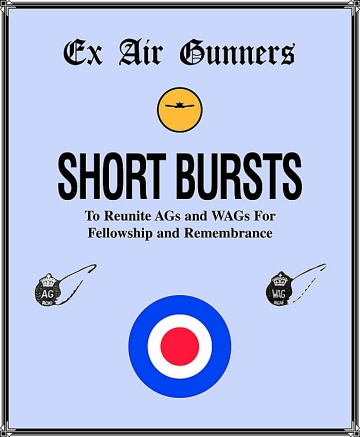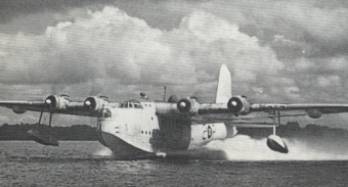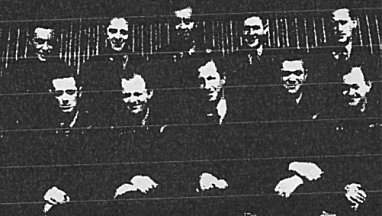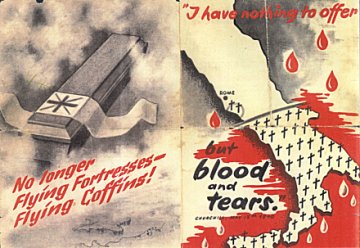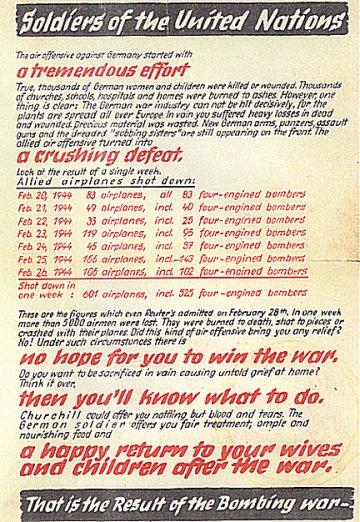The crew completed all major exercises by
the middle of February 1944 and were posted to RCAF 422 Squadron at Castle
Archdale, Northern Ireland. We expected that we were now fully qualified
to conduct reconnaissance missions and convoy escort patrols. To our surprise
we continued to fly and train in aerial combat with our own fighter aircraft,
practice bombing of marked water targets and air to ground machine gun
attacks.
Finally the command felt that the crew was ready for
combat action and were assigned Sunderland EK591. In the mean time our
Skipper, Frank Morton, was promoted to the rank of Warrant Officer. Our
crew's first operational flight was scheduled for March 10, 1944, to patrol
a designated area in the North Atlantic.
Following the aircrew briefing pertaining to patrol
area, weather conditions, etc., the crew boarded the Sunderland Flying
Boat EKL591 on Loc Erne, Northern Ireland. Prior to take-off Squadron Leader
Brian Young, in charge of Operations, came aboard the aircraft to wish
us well. In addition, F/L Sid Butler and 2nd. Navigator F/L A. Omeron became
part of our crew on this trip to ensure our safety. A .5 machine gun was
installed in the nose of the aircraft. Take off time took place at 11:25
a.m., March 10,1944, for the patrol area in the North Atlantic. In
less than five hours after take-off on our first operational trip every
member of the crew was put to the test after months of teaching, learning,
and practicing. The day was bright and sunny with unlimited visibility.
At 1500 hours, before we reached the patrol area a U-Boat was sighted simultaneously
by F/L Butler from the first pilot's seat and Flight Sergeant W. Roberts
from the front gun turret. F/L Butler, who was nearing completion of a
tour of operations was screening the captain of the aircraft, W/O Morton,
on his first operational sortie as Captain. All guns were test fired immediately
and I positioned myself to operate the .5 gun in the nose of the aircraft.
The U-Boat had ample time to dive long before we reached
the sub but it decided to remain on the surface and fight it out with the
aircraft. I was unable to notify the captain that I was prepared
and ready to operate the .5 machine gun because the intercom, normally
beside the .5 location was missing. Captain Morton sent F/O Simard, our
second pilot to see where I was. I informed him that I was ready
and not to stand behind me. The manoeuvring and counter manoeuvring of
he U-Boat and the aircraft began in earnest. The U-Boat kept turning to
keep the stern towards the aircraft for maximum fire power. The aircraft
took evasive action and the U-Boat continued to fire at the aircraft without
success.. Because the Plexiglas window in the nose of the aircraft was
scratched and dirty, I opened the window for a better view. Unbeknownst
to me Captain Morton had turned over the controls to F/L Butler for
the attack. F/L Butler, an experienced pilot, tried to manoeuvre the aircraft
for the front bow attack with some success and quickly dropped the aircraft
to 400 feet in a steep dive towards the U-Boat and, levelling off at 50
feet, it appeared that we would hit the conning tower with the bottom of
the aircraft. Once the frontal attack started and the U-Boat came into
full view of the frontal guns they opened fire and silenced the guns on
the U-Boat. The main attack lasted less than two minutes. I fired 350 rounds
of ammo wih the .5 machine gun. F/L Butler did a superb job of dropping
six depth charges straddling the U-Boat behind he conning tower.
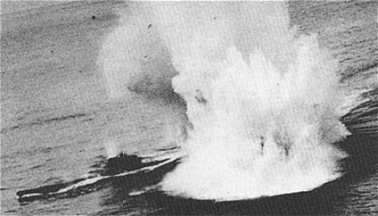
Main Explosion
The 20mm cannon on the U-Boat was pointed at an angle
skyways and, to my surprise, I saw one brave German running towards the
cannon. He pulled the trigger and fired one shot at the aircraft. I continued
to fire the .5 machine gun until we flew past the sub and, leaning forward,with
my feet spread apart for better control of the gun, I heard an explosion
and noticed a light below the aircraft. The submarine's cannon had opened
a hole in the fuselage approximately ten inches in diameter between my
feet. I saw no blood and proceeded to lift my right foot and then my left
foot which appeared to be still intact. We had been told at training
sessions that quite often you do not feel pain after being hit.
Fortunately an explosive shell was in the breach which
exploded on impact. The shell fragments hit the frontal partition wall
in the fuselage and peppered it with holes. An armour piercing shell would
have gone through the aircraft from bottom to top and in all likelihood
would have killed most of the crew.
I still couldn't believe that I wasn't hit until I
walked away from the machine gun and met the fellow crew embers who inspected
me for blood. Mind you, they did not help matters by any stretch of the
imagination by saying, "Almost a bouquet on your grave, Joe."
The crew had responded with perfection after several
months of training.
After the attack the aircraft circled. Three minutes
had elapsed when the U-Boat submerged but resurfaced after another three
minutes moving at a very slow speed and turning to starboard. While there
appeared to be a considerable amount of fuel oil slick around the U-Boat,
we were uncertain as to whether we were successful in damaging the sub
beyond repair as it continued to float on the surface. As we were out of
depth charges, some consideration was given to attacking the U-Boat with
frontal guns in the aircraft. This proposal was quickly disregarded as
the guns alone could not sink the sub. All guns on the aircraft and the
U-Boat remained silent and it was decided to play a waiting game to see
the final outcome. In
any case no Germans were seen on top of the U-Boat.
Operational headquarters were constantly kept informed of all our activities
by Flight Sergeant C. Holland via radio with a request for assistance.
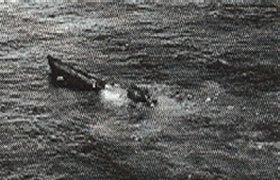
Sub sinking
One hour and twenty-eight minutes later the U-Boat
flashed "Fine Bomish" by altis lamp and the crew started to abandon the
sub in numerous small dinghies. At 17:40 hours the U-Boat sank beneath
the surface. A Sunderland aircraft from the sister squadron 423 was dispatched
to our area. This aircraft was the closest patrol aircraft to the area
and arrived shortly after the U-Boat sank. We were still circling the dinghies
occupied by the survivors.
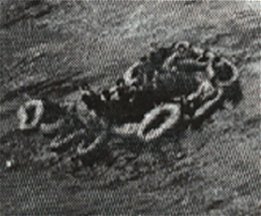
Survivors in life rafts
While we were quite jubilant to see the Germans vacating
the U-Boat and entering the dinghies, several thoughts went through my
mind . Firstly, that I could have been killed or maimed by the gun fire
on the initial attack and secondly, that it could have been some of us
floating in the dinghies instead of the Germans.
Seventeen U-Boat seamen survived the sinking, including
three officers who stood up in the dinghy and gave the Heil Hitler salute
as their U-Boat was going under. A British war ship was patrolling the
shipping lanes in close proximity to the sinking site and was requested
to pick up the seventeen survivors.
Even thought the hole in the fuselage was slightly
above the water mark, to land the aircraft with a gaping hole would have
been a problem. The task to repair the hole became a major concern. Sergeant
Ted Higgins, aircraft engineer, found some sheet metal pieces large enough
to more than cover the hole. It was necessary to firmly brace the sheet
metal into place so that it would not become disengaged during landing.
With the patch in place F/L Butler inspected the repairs and was
satisfied that he would be able to land the aircraft safely.
By the time we returned to the operational base at
Castle Archdale it was already dark which made the landing that much more
difficult. The rescue boats were alerted and in place in case we could
not save the aircraft. The crew members were in position and braced for
landing. F/L Butler landed the plane on the flare path with the nose slightly
higher than normal and taxied firmly on the step all the way to the ramp
where crews were ready to remove the aircraft from the water. The patch
held with only a small amount of water penetrating the hull.
The debriefing of the crew was probably worse than
the attack itself. It lasted for hours. We were all very tired with over
12 hours in the air and perhaps the most dramatic experience of our lives.
I remember a rather stupid question, "What improvements would you recommend
to improve future attacks on U-Boats?" I replied rather sarcastically,
"It is hard to improve on a perfect attack."
It was then we found out there were pictures. By pressing
the release button on the pilot's controls which dropped the depth charges
also automatically activated the rear facing camera. The entire attack
was photographed and some of the best pictures of a submarine attack in
the war was captured on film.
F/L Sid Butler immediately received the Distinguished
Flying Cross.
Warrant Officer Frank Morton was recommended for a
King's Commission.
The German Submarine U625
Information obtained from Germany
Type: VIIC
Weight: 769 tons
Commander: Kapitan Leutnant Hans Becker.
Leutnant Becker had also commanded U152 and U80
War Service of Submarine U625
-
6.11.1942: sinks the Empire Sky 7455 tonnes
-
16.11.1942: sinks the Chulmleigh 5445 tonnes at Southern
Cape of Spitzbrergen
-
23:11.42: sinks a ship from a convoy called Goolistan
5851 tonnes
-
20.7.1943 to 10.8.1943: destroys the Soviet trade in Pecora
Sea ~ a minefield in front of the Jugor-Strabe
-
13.6.1943 to 25.9.1943: mining activities in the Kara
Sea east of the Jugor-Strabe around the submarine group "dachs"
-
23.12.1943 to 8.11.1944: 625 belongs to the submarine
group "Rugen 6" West of Ireland
-
2.1.1944: Kapitan Leutnant Becker and 1 Rating lost overboard
~ Attacked by G/224 Squadron Catalina Flying Boat ~ Command of U625 taken
over by Kapitnan Leutnant Peter Straub
-
10.3.1944: 625 sunk by aerial bomb from flying boat of
422 Squadron RCAF ~ Submarines U7412 and U256 are ordered to help ~ Two
days after the attack the crew of U625 perished in high seas.
MEMORIAL SERVICE TO HONOUR TWO
REGINA MEN
Leader Post July 8, 2002.
By Will Chabun
Sixty years to the day after they died in the North
Pacific, two Regina Airmen and six of their buddies will be saluted in
a memorial service. And the organizer wants to make sure their families
know about this.
This story starts in August 23, 1942, nine months into
the Pacific war, when a Stranraer flying boat from RCAF's 120 Squadron,
operating from Coal Harbour on Vancouver Island, disappeared on a patrol
flight.
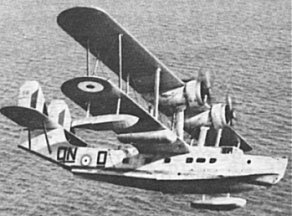
Stranraer Flying Boat
No race of the large twin-engined aircraft and its
eight crewmen was ever found. All eight were declared missing and presumed
dead. The Reginans were Sgt.Chrles Franklin Beeching, and F/Sgt. Lawrence
Alfred Bernd Horn. Organizing the Memorial Service, to be held in Victoria's
Royal Oak Burial Park on August 23, 2002, is Traer Van Allan, cousn of
the Stranraer's Pilot, F/O Everard Thomas Cox of Vancouver.Beeching lived
at 933 Edgar St. and Horn resided at 3415 Victoria Ave.
Van Allen determined to organize this service after
co-ordinating one last year for his brother, posted missing and presumed
dead in Goose Bay area in September 1941.
Van Allen said RCAF records insicte the men lost in
1942 were reported missing while attafcking a Japanese submarine off the
Western coast f Vancouver Islnd. The RCAF official history does not mention
this incident, but notes many sightings of, and two attacks, by Japanese
submarines off B.C. that summer.
The other men were F/O E.T. Cox of Vancouver, F/Sgt.
Mervin Cram of Renfrew, Ont.; Sgt. A.W. Anderon of Selkirk, Man; Leslie
Oldford of Penhold, Alta., lus two Sgts. from Vancouver, Kenneth Hope (also
listed as having relatives i Saskatooon) and Robert Stuart.
The August 23 service will see the unveiling of a large
red granite memorial bearing the names of the eight airmen, whose bodies
were not found. "These guys were Canadian Heroes and they weren't even
given a funeral," said Van Allen.
Family members or others wishing to attend this service
can contact the Royal Oak Buriel Park at (250)658-5621.
The account of F/O Cox and crew on Stranraer 951
is recorded in more detail in Chris Weicht's book
JERICO BEACH and the West Coast Flying Boat Squadrons
pg. 103/104.
Pages 103/104: "On August 23, 1942, F/Sgt E.T.
Cox and a crew of seven airmen, took off at 0920 hours on a long patrol
for the day. Nine hours later, about ninety miles North West of Cape Scott,
#951 developed engine trouble and F/S Cox was forced to ditch the aircraft.
The wireless operator sent out an S.O.S. giving their position and
short cryptic message that they were down at sea and sinking. The navy
was advised, and the five remaining aircraft on the station (Coal Harbour)
were immediately dispatched.
Two hours later F/O Snyder and crew of Stranraer #952
sighted #951 - some of the #951 crew had climbed out on the wing to wave
and cheer at the approaching stranraer. The high seas made landing impossible,
but the crippled aircraft's wireless operator F/Sgt. Cram signalled
that they were all relieved to be spotted and everything was fine, with
the exception of their aircraft which was taking a beating in the rough
sea. F/O Snyder advised dispatch that they were now experiencing some engine
trouble. He was ordered, if possible, to circle over the ditched aircraft
until Stranraer #950 could get there to relieve them. The high speed launch,
'Malecite' M.231, which was waiting for orders in Quatsino, was dispatched
to the position to pick up the crew, and all the other aircraft were ordered
back to base. As total darkness closed in, it seemed that the situation
was in hand.
Somewhere in their circling pattern, in the blackness
beneath them, the crew of #952 lost sight of #951. #950 arrived and searched
the area but returned to Coal Harbour station with negative results; the
'Malecite' also returned and reported that they had found nothing. F/O
Wayave in Sranraer #909 was within sight of the search area when his aircraft
also developed engine trouble and had to turn back. He reported sighting
a submarine that he thought was moving in the direction of the downed aircraft.
Wayave, who was awarded the Air Force Cross for his
courageous work in trying to locate the lost aircraft, returned to the
station and took off again in one of the Stranraers fitted with long range
tanks. In spite of poor weather conditions with a cloud ceiling sometimes
as low as 100 feet, he circled the crash site throughout the night. As
dawn came he saw no trace of #951 or his fellow Airmen. Along with other
searchers he refused to give up hope and continued to fly long hours in
the next week as the search area was expanded.
S/L Carpenter, operating out of RCAF Station
Ucluetlet, took personal charge of the organized search over the enlarged
area. Aircraft from Coal Harbour, Bella Bella, Ucluelet, and Patricia Bay
made extensive sweeps in criss cross patrols, but the results continued
to be negative. At the end of August no clue had been uncovered to explain
the total disappearance of Stranraer #591 and its crew of 8 Airmen. The
Japanese submarine sighted so close to the crash point also remains part
of the mystery."
Fred Burnyeat Ex AG Member (Saskatoon) was stationed
at #4 BR Squadron, Ucluelet, at the time and carried out a number of search
patrols.
Chris Weich's book, JERICO BEACH records other evidence
of enemy submarines on the West Coast including an attack on a submarine
off the Queen Charlotte Islands October 27, 1942, by a Blackburn Shark
crew from #7 BR Squadron, Prince Rupert.
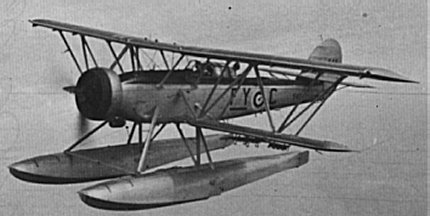
Blackburn Shark 545 #7 B.R.
Squadron
The book also records the sighting of a Japanese submarine
borne Yokosuka E14Y1 "Glen" reconnaissance aircraft flying over Prince
Rupert in February 1942. At the time, all this activity on the West Coast
was Top Secret and the Canadian public were kept in the dark to prevent
panic.
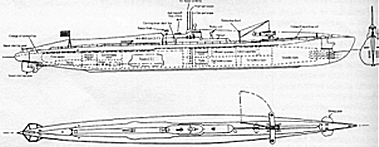
Japanese Sub showing aircraft mount.
A DOUBLE SIDED GERMAN PROPAGANDA
SHEET
USED AGAINST THE ALLIES IN ITALY:
From the Homefront Archives & Museum, 6015-5th
Ave., Regina Sk, Canada S4T 6V4
Paper propaganda sheets dropped by air or by special
artillery shells were a form of psychological combat utilized by all nations
during WW11. Intended to demoralize the enemy, with the hope they would
surrender to the promise of proper care, ample food,and the security of
being safe until the war ended.
Most recipients made good use of the pamphlets
as toilet paper, which explains the rarity at this time. Complete records
of the variations and their volume were never retained. It does make an
interesting field for the collectors of today. Most Bomber crews
started operations with a ‘Nickel’ trip spreading propaganda leaflets over
enemy territory.
Robert Henderson
owns and operates the
Homefront Archives & Museum at Regina, Saskatchewan,
Canada,
and has published the following book.
GERMAN PRISONERS OF WAR IN CANADA AND THEIR ARTIFACTS
1940 - 1948
by Rober Henderson and C.M. Madsen.
ISBN 0-9697888-0-0 SOFT COVER 6" X 9"
203 PAGES
Price - $28.00 (Can) includes mailing cost.
Details: the definitive book on the history, activities
and collectable artifacts of German Prisoners of War (with some Veteran
Guard of Canada) artifacts from the Second World War.
Documented details including photographs, locations
of branch camps, Labor Projcts, Military Hospitals, and Detention Centers.
The book includes a special section on the collecting of artifacts relating
to these Prisoners, including eighty eighty photogrphs of "Collectibles"
currently held in the Homefront Archives & Museum at Regina, Saskatchewan.
The book provides the historian, the researcher, and
the colletor with details not found in any other publication! Extensive
Bibliography. The book is available from:
Robert J. Henderson, 6015-15th Ave. Regina,
Sk. S4T 6V4 Canada.
Email homefront@sasktel.net
CORRESPONDENCE
British Columbia Branch
Meeting time: The second Tuesday of every month at
11.30am
Local: Firefighters Social & Athletic Club, 6515
Bonsor Avenue, Burnaby ~ 604-437-4347
NB: Wives and lady friends are most welcome at all
meetings.
Contact: Dave Sutherland. Email: distilledwater@shaw.ca
Phone:604-431-0085
Dave Sutherland
Re: Lyle Peace Aus439229
Dear Sir,
I have just visited your Ex Air Gunners Web site,
whilst looking for any information about training aircraft.
I was hoping to find out some information about the
aircraft that my late father-in-law (Lyle Peace Aus439229) trained
on whilst in Canada during 1944/45.
He trained as a radio operator from 2/8/44 to19/12/44
and his flight log is stamped by the
O.C. AIR OPERATIONS SECTION No. 3 WIRELESS SCHOOL
Which I believe was in WINNIPEG?
He then trained as a gunner from 28/1/45 to 17/2/45
at #9 B & G School ~ Mont Joli
In his flight log for these periods under Aircraft
Type and No, all the entries appear to be call signs
eg - N2477, Y3394, Y3413 and
N 2474 - Battle 51, Battle107 etc.
All the information that I have at this time is two
name - Yale and Norseman, but I am unsure about them. I also believe that
he went to NASSAU in the BAHAMAS and was involved in some bombing training
as well. Any information that you or any of your members can help me with
will be greatly appreciated and I take this opportunity to thank you for
any assistance.
Bob Offer
(Ed. Send replies to Editor)
Northern Saskatchewan Branch
Smokey Robson phoned to say that their July
meeting was well attended and that their Group is still quite active.
422 Squadron Reunion - Sept. 26 - Sept. 30, 2002.
Winnipeg, Manitoba. Contact person Jack
Logan
njlogan@telus.net
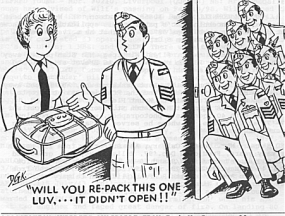
OBITUARIES
GROUT, WILLIAM #0262, BURNABY, BC: Bill passed away
in June after a short illness. Enlisted as R109214 as a Carpenter,
previously a member of the Calgary Highlanders Regiment from early 1940
to mid 1942. Remustered to Air Crew and Posted to #3 Manning
Depot in Edmonton where he was selected for Gunnery Training. Attended
BC University for PAED training then on to #3 B&G at MacDonald, MB.
Overseas he was posted to #75 (New Zealand) Squadron in RAF 3 Group at
Mepal, Cambridgeshire where he completed a 36 Ops Tour as a Rear Gunner
on Lancasters. Following the war Bill spent 30 years on the Vancouver
Police Department
HUMPHREYS, C. MBR #0549, CALGARY, AB: Cecel passed
away at the Foothills Hospital on Sunday, July 7, 2002 at age 83.
Service No. C89652, Air Gunner and served with 405 Squadron in the UK with
6 Group. He was a talented Mechanic who spent 26 years in the trucking
industry. There was no service as per his request.

Good Lord Willin' and if the creek don't rise, we will
get another Issue of Short Bursts out September 2002.
Again, I encourage Members to send me articles for
future pages, otherwise we will have to glean articles from old copies
of Short Bursts. That would be like recycling yesterday's chewing gum off
the bed post!
Keep well.
John & Doreene Moyles
Editors
